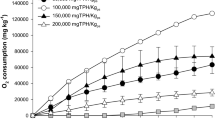Abstract
The occurrence, vertical distribution, and physiological state of microorganisms in a petrochemical oily sludge deposit were studied. The total number and the number of viable microbial cells at depths of 0.2 and 3 m were about 1010 and 108 cells/g dry wt sludge. Most microbial cells taken from the middle (1 m deep) and the bottom (3 m deep) sludge horizons showed a delayed colony-forming ability, which suggested that the cells occurred in a hypometabolic state. The relative number of microaerobic denitrifying microorganisms steeply increased with depth. The amount of microorganisms tolerant to 3, 5, and 10% NaCl and capable of growing at 7 and 40°C varied from 102 to 108 CFU/g dry wt sludge. Petrochemical oily sludge was found to maintain the growth of heterotrophs, among which the degraders of oily sludge and ten different individual polycyclic aromatic hydrocarbons were detected. The occurrence of highly adaptable microorganisms with an adequate metabolic potential in the petrochemical oily sludge deposit implies that its bioremediation is possible without introducing special microorganisms.
Similar content being viewed by others
REFERENCES
Yakusheva, O.I. and Naumova, R.P., Biotechnology for Purification of Wastewaters from a Petrochemical Plant, Problemy bio-i med-ekologii Respubliki Tatarstan (Problems of Bio-and Medicinal Ecology in the Tatarstan Republic), Kazan: Ekotsentr, 1998, no. 1, pp. 168-188.
Ogri, O.R., A Review of the Nigerian Petroleum Industry and the Associated Environmental Problems, Environmentalist, 2001, vol. 21,no. 1, pp. 11-12.
Londry, K. and Suflita, J., Use of Nitrate to Control Sulfide Generation by Sulfate-reducing Bacteria Associated with Oily Waste, J. Ind. Microbiol. Biotechnol., 1999, vol. 22,no. 6, pp. 582-589.
Giles, W.R., Kriel, K.D., and Stewart, J.R., Characterization and Bioremediation of a Weathered Oil Sludge, Environ. Geosci., 2001, vol. 8,no. 2, pp. 110-122.
Vasudevan, N. and Rajaram, P., Bioremediation of Oil Sludge-contaminated Soil, Environ. Int., 2001, vol. 26,no. 5–6, pp. 409-411.
Yakusheva, O.I., Nikonorova, V.N., Kiyanenko, G.V., Kachalina, O.V., Aliulova, R.A., Abuzyarova, V.V., Nikitina, E.V., and Naumova, R.P., Characterization of the Chemical Composition of Oily Sludge, a Waste from the Petrochemical Industry, Materialy VI Mezhdunar. konf. “Neftekhimiya-2002” (Proc. of the 6th Int. Conf. “Petrochemistry-2002”), Nizhnekamsk, 2002, pp. 271-276.
Bartha, R., Biotechnology of Petroleum Pollutant Biodegradation, Microb. Ecol., 1986, vol. 12,no. 1, pp. 155-172.
Castaldi, F.J. and Ford, D.L., Slurry Bioremediation of Petrochemical Waste Sludge, Water Sci. Technol., 1991, vol. 25,no. 3, pp. 207-212.
McMichael, A.J., Carcinogenicity of Benzene, Toluene, and Xylene: Epidemiological and Experimental Evidence, Environ. Carcinogen. Methods, Anal. Exposure Means, Benzene and Alkylated Benzenes, Lyon, 1988, vol. 10, pp. 3-18.
Styrene: Environmental Health Criteria, Geneva: World Health Organization, 1983.
Menzie, C.A., Potocki, B.B., and Santodonato, J., Exposure to Carcinogenic PAHs in the Environment, Environ. Sci. Technol., 1992, vol. 26, pp. 1278-1284.
Lazar, I., Dobrota, S., Voicu, A., Stefanescu, M., Sandulescu, L., and Petrisor, I.G., Microbial Degradation of Waste Hydrocarbons of Oily Sludge from Some Romanian Oil Fields, Petrol. Sci. Eng., 1999, vol. 22,no. 2, pp. 151-160.
Mishra, S., Jyot, J., Kuhad, R.C., and Lal, B., Evaluation of Inoculum Addition to Stimulate In Situ Bioremediation of Oily Sludge-contaminated Soil, Appl. Environ. Microbiol., 2001, vol. 67,no. 4, pp. 1675-1681.
Kozhevin, P.A., Mikrobnye populyatsii v prirode (Microbial Populations in Nature), Moscow: Mosk. Gos. Univ., 1989.
Methods of Taxonomic Analysis, Metody pochvennoi mikrobiologii i biokhimii (Methods of Soil Microbiology and Biochemistry), Zvyagintsev, D.G., Ed., Moscow: Mosk. Gos. Univ., 1991, pp. 131-133.
Kogure, K., Simidu, U., and Taga, N., A Tentative Direct Microscopic Method for Counting Living Marine Bacteria, Can. J. Microbiol., 1979, vol. 25,no. 3, pp. 415-420.
Manual of Methods for General Bacteriology, Gerhardt, P. et al., Eds., Washington: Am. Soc. Microbiol., 1981. Translated under the title Metody obshchei bakteriologii, Moscow: Mir, 1984.
Lur'e, Yu. Yu., Analiticheskaya khimiya promyshlennykh stochnykh vod (Analytical Chemistry of Industrial Sewage Waters), Moscow: Khimiya, 1984, pp. 74-77.
Kulichevskaya, I.S., Milekhina, E.I., Borzenkov, I.A., Zvyagintseva, I.S., and Belyaev, S.S., The Oxidation of Oil Hydrocarbons by Extremely Halophilic Archaeae, Mikrobiologiya, 1991, vol. 60,no. 5, pp. 860-866.
Zvyagintseva, I.S., Poglazova, M.N., Gotoeva, M.T., and Belyaev, S.S., Effect of the Medium Salinity on Oil Degradation by Nocardioform Bacteria, Mikrobiologiya, 2001, vol. 70,no. 6, pp. 759-764.
Author information
Authors and Affiliations
Rights and permissions
About this article
Cite this article
Nikitina, E.V., Yakusheva, O.I., Zaripov, S.A. et al. Distribution and Physiological State of Microorganisms in Petrochemical Oily Sludge. Microbiology 72, 621–627 (2003). https://doi.org/10.1023/A:1026063805092
Issue Date:
DOI: https://doi.org/10.1023/A:1026063805092




